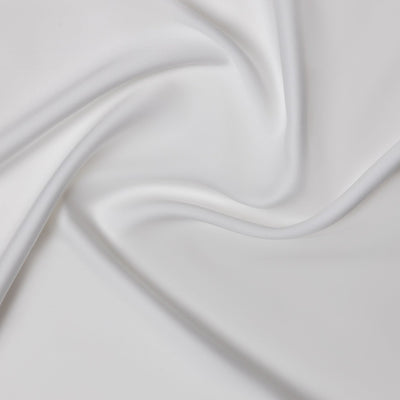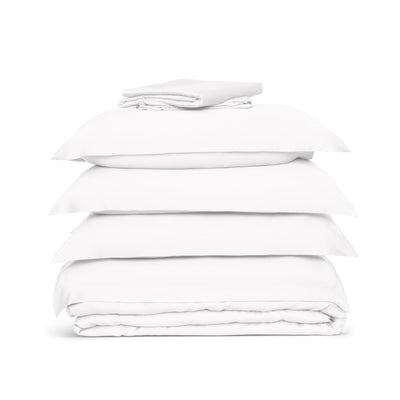Washing your bedding isn’t always an exact science, and there can sometimes be a little confusion around what settings to choose on your machine. Fortunately, we’ve created the ultimate guide to choosing the optimal laundry temperature and spin speed.
In this article, we’ve explained what the differences are between a hot and cold wash, which of the two you may want to choose depending on your type of bedding, and how to confidently wash your next load. So, without further ado, how do you go about cleaning bed sheets?
Bedsheet Washing Temperature Calculator & Tool:

Select Your Bedding Material
Select a material to see more information.
This tool is provided by Ethical Bedding. For more information and to use this tool on your site, visit ethicalbedding.com.
Is it better to wash sheets in hot or cold Water?
There’s often some debate about whether you should wash your bed sheets on a hot or cold cycle. The truth is, there are benefits to both options, and there may be some instances where a hot wash is preferable, and vice versa. To straighten things out, we’ve outlined the pros and cons of hot and cold water washing.
Understanding hot and cold water washing
Before we go into the differences and benefits of each, it’s important to understand what we actually mean by hot and cold water washing:
- A cold-water wash typically refers to a cycle that runs at a temperature between 20° and 30°.
- A warm-water wash typically refers to a cycle that runs at a temperature of around 40°.
- A hot-water wash typically refers to a cycle that runs a temperature exceeding 40°.
Pros and cons of hot water when washing bed sheets
When it comes to the advantages of washing sheets in hot water, the main benefit is the high temperature’s effectiveness against potentially harmful bacteria (and particularly persistent stains!). This is something you can’t always get with a low-temperature spin, so bear it in mind when loading your laundry.
However, the main disadvantage of washing sheets in hot water is the potential for fabric damage, especially if you have delicate fabrics. Though hot water is useful in combatting germs, it’s also known to contribute to colour fading, quicker wear and tear, and shrinkage.
Pros and cons of cold water when cleaning bed sheets
Just as there are reasons to put on a hot wash, there are benefits of washing your bed sheets with cold water too; the most noteworthy of which is the gentleness with which the cycle treats your bedding and fabrics.
This is an especially useful benefit if you’re trying to prolong the life of your bed sheets. Additionally, there are environmental and economic advantages of washing sheets in cold water, with the lower laundry temperature requiring a smaller energy spend.
However, on the flipside, when spinning sheets on a low temperature cycle, it’s important to read the specific washing requirements to make sure you’re effectively-combatting germs, mites, and bacteria.
When to use warm water to wash your sheets
Typically, you should be able to wash your bed sheets with cooler water, so don’t be afraid to keep the laundry temperature down (unless your bedding’s specific label suggests otherwise). However, there are instances when it might be beneficial to use warmer water instead:
- Stained sheets: more often than not, washing your sheets on a hot setting will do a great job at removing persistent marks and stains. But not only that; it helps to thoroughly clean the natural oils, dirt, and grime that you’ve accumulated simply by sleeping, which is particularly useful during the hot and sweaty summer months. However, just be aware that hot water can actually set certain stains, such as wine, coffee, and blood, so it may be useful to seek advice in these instances.
- Combat pollen and allergens: if you’re especially prone to the effects of pollen or other common allergens, you may benefit from putting your bedding through a warm or hot water wash, to help keep your sheets comfortable. Alternatively, you could keep an eye out for hypoallergenic bedding.
- Kill germs and bacteria: finally, another important reason to use warm water to wash your sheets is to kill present germs and bacteria. Examples of instances where this might be necessary are if you’ve recently suffered from illness or if you regularly let your pets snuggle up close.
Top tip: If you do intend to wash your sheets with warm water, it can be useful to pre-treat prominent stains (to prevent them from setting) and check the colourfastness of your bedding – not all dyes are resistant to fading or running in hot conditions.
When to use cold water to wash your sheets
As we’ve alluded to, in the majority of cases, your bedding and sheets should be washable on a low-temperature cycle, which can help to prolong their life while also reducing the amount of energy you’re consuming. Examples of instances where a colder wash might be beneficial include:
- Everyday washing: if you’re only putting your bed sheets through a routine wash, you may not need to up the temperature beyond a cool 30°. For instance, if you’ve no obvious stains and you’re just conducting your weekly laundry.
- Delicate fabrics: if your bedding is made using a delicate fabric like silk or bamboo, you may want to put them on a colder wash to prevent damage to the fibres. If you’re ever unsure, your best bet is to check the care label on your bedding and sheets.
- Brightly coloured: if you have brightly coloured bedding, you may be concerned about the dye running or fading. However, washing your sheets on a cooler setting should prevent damage, and will maintain the vibrancy. Again, if you’re uncertain, consult your care labels.
Top tip: If you do intend to wash your sheets with cold water, it can be useful to ensure you’re using an appropriate cold-water detergent and selecting a gentle cycle.
What temperature to wash sheets at?
Now you’re pretty clued up on the differences between a cold and warm wash, and the benefits of each, it’s time to delve into the optimal washing temperature for each type of bedding. So, from cotton and linen to sustainable bamboo and eucalyptus silk, read on to discover what laundry temperature to wash sheets on.
Cotton sheets
Typically, cotton sheets are relatively easy to care for, and you can wash them on just about any setting. This is because the fabric is pretty durable and can tolerate any washing temperature.
So, feel free to select the setting you’re most comfortable with, whether that’s a cooler cycle for your weekly wash or a hotter wash to get rid of those persistent stains or germs and mites.
Linen bed sheets
Because linen is a relatively delicate fabric, it’s often best to wash these sheets on a low-temperature and gentle cycle, taking note of any other specific instructions on the care label. Putting your linen through a hot wash may quickly end up damaging the fibres and, in some cases, even result in shrinkage.
For best results, it’s often advised to wash linens with a moderate detergent and avoid overloading your machine to let the bedding properly circulate.
Bamboo bed sheets
When washing bamboo bedding, it’s essential to avoid warm or hot water, and instead opt for a cool spin that protects the fabric fibres from becoming damaged. This means keeping your washing machine at a temperature below 30°C and setting it to a gentle cycle.
For the best results, never use bleach and avoid fabric softeners, as these can contain harmful chemicals. Fortunately, bamboo is naturally silky and will get softer with each wash anyway.
If you’re interested in learning more about choosing the right washer setting, discover our guide to caring for bamboo bed sheets.

Shop Our Fitted Or Flat Sheet For Your Perfect Bed
Silk bedding and satin sheets
Because of the delicate nature of silk and satin (and its ethical alternative eucalyptus silk bedding), it’s important that your washing machine is set to a low-temperature and gentle cycle. Otherwise, you risk significantly and irreparably damaging the fibres. To prevent snagging even in cool water, it can also be useful to use a mesh laundry bag.
What water temperature kills bacteria in a washing machine?
Whether you’re running your sheets through a regular cycle, you’re addressing spills and stains, or you’ve recently spent a few days in bed with illness, it’s perfectly natural to be a little concerned about the presence of bacteria.
The simplest way of killing horrible germs is to put your bed sheets through a hot water wash. This means setting your machine to a 60° cycle. Of course, this isn’t appropriate for all types of bedding, which is why we’ve offered a couple of alternative solutions.
- Use a sanitising detergent: because not all fabrics can be washed on a hot setting, it’s important to use a disinfecting laundry detergent. Many examples contain bleach, however there are detergents that are non-toxic and free of harmful chemicals, which is always preferable (for your own health as well as that of your bedding).
- Dry your bedding in the sun: once your bedding has run through the washing machine, it’s helpful to air dry it in the sun. This is because the sun is a natural disinfectant and will help to eliminate any lingering bacteria or germs.
How to wash bed sheets in a washing machine
When it comes to washing bed sheets, you’ll need to follow three simple steps: choosing and measuring your detergent, selecting an appropriate setting, and identifying the correct spin speed.
1. Add the right amount of detergent
When putting your bedding through a spin cycle, it’s important to add the right amount of chemical-free detergent, as this can impact both the resulting cleanliness and lifespan of your sheets.
To best-gauge the right amount, consult the instructions on your laundry powder box or detergent bottle, however, just be conscious that the amount may vary depending on the load size, water hardness, and level of staining.
2. What setting to wash bed sheets?
Once you’ve added your detergent, it’s time to select the appropriate setting for your bedding material and level of staining. As we’ve highlighted, some fabrics can tolerate hotter temperatures, while some can only be washed on a cooler cycle, so take note of the recommended settings on your bed sheet’s care label.
3. What spin speed to use for bed sheets?
Choosing the right temperature is one thing, but you’ll also likely need to select a cycle speed before you can set your washer. As with temperature, some fabrics are relatively resilient and can tolerate quicker speeds, but some like silk, bamboo, and linen benefit from a gentler cycle.
Knowing what temp. to wash sheets at isn’t always an exact science, but hopefully you now feel a little better-prepared to tackle your next load of laundry, no matter the type of bedding you own!
If you’ve found this article helpful, check out the Ethical Bedding blog for even more insight from our team of experienced sleep experts, including how to whiten yellow bed sheets.
















